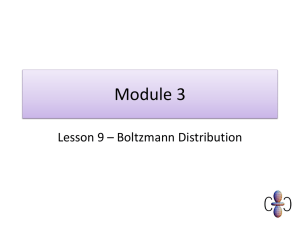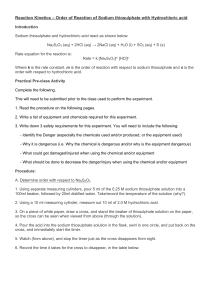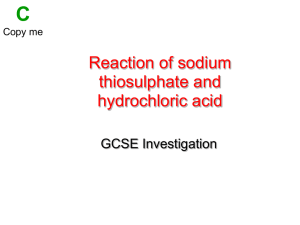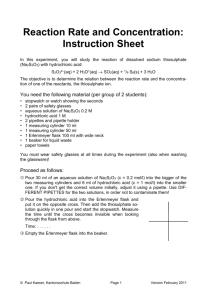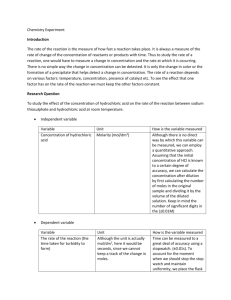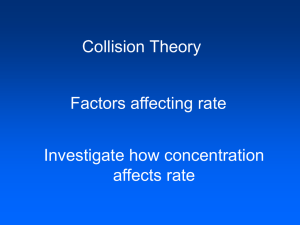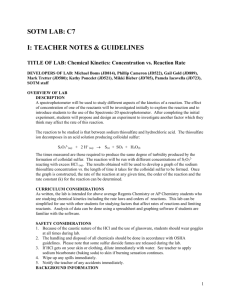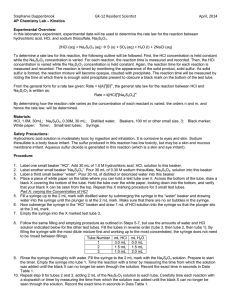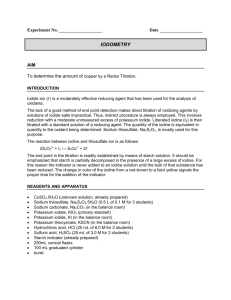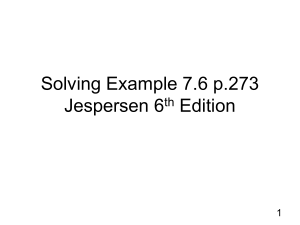Lesson 10 – Practical and Arrhenius
advertisement
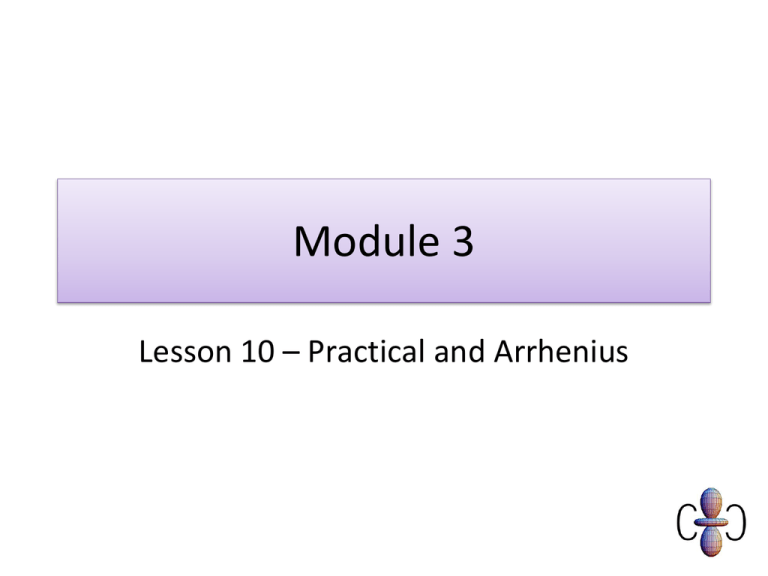
Module 3 Lesson 10 – Practical and Arrhenius Objectives Must Describe qualitatively, using the Boltzmann distribution, the effect of temperature changes on the proportion of molecules possessing a certain energy. Should Conduct an experiment to investigate the effect of temperature on rate of reaction. Could Manipulate the results of the experiment to calculate the activation energy using a graphical method and the Arrhenius equation. Starter homework – peer assess An experiment is conducted to measure the rate of hydrogen peroxide decomposition. Using collision theory and the Boltzmann distribution explain the following observations. • When the temperature is raised by 20°C from 20°C to 40°C the rate increases to more than four times the original rate. • A catalyst is tested at 40°C which increases the rate of reaction still further to double the previous rate • Heating the mixture containing the catalyst still further to 50°C caused the reaction rate to fall. [10 marks] • In order to react molecules need to collide in the correct orientation and with sufficient energy [1 mark] • The Boltzmann distribution shows the number of molecules with a certain energy. The number of molecules with the Ea is shown as the shaded area [2 marks] • Diagram [2marks] • When the temperature is higher the curve gets broader and the shaded area gets MUCH bigger. Many more molecules have enough energy to react when they collide. [1 mark] • A catalyst reduces the activation energy (shown illustrated OK) [1 mark]. • This increases the proportion of molecules possessing the activation energy / area under curve increases [1 mark]. • The catalyst is an enzyme which becomes denatured at >40°C. [1 mark]. • The activation energy returns to the uncatalysed value and rate falls. [1 mark] The Reaction Dilute hydrochloric acid reacts with sodium thiosulphate solution to give a precipitate of sulphur Na2S2O3 (aq) + 2HCl (aq) 2NaCl (aq) + H2O (l) + SO2 + S (s) Practical • Using fixed concentrations of 0.5M HCl and 0.1 M Na2S2O3, investigate the effect of temperature on the rate of reaction. • You should investigate 5 different temperatures with three repeats across the whole group. • Your temperatures should span approximately (but recorded accurately) 5°, 10°, 20°, 30°, 40° • To do the repeats have all your boiling tubes containing your reactants in the water bath/trough at the same time. Plenary • Plot three graphs and bring to next lesson • Time taken (t) against temperature (T) • Rate (1/t) against temperature (T) • ln(1/t) vs. 1/T Extension – The rate equation Rate of reaction is dependent on the concentrations of reacting species • Our reactants are Na2S2O3 and HCl We can say that • RATE = k[Na2S2O3]m[HCl]n • Where [Na2S2O3] is the concentration of thiosulphate in mol/l and • [HCl] is the concentration of HCl in mol/l Extension - Arrhenius Rate = k[a]x[b]y For constant [a] and [b] ie concentration kept constant Rateµk µ 1 K = AexpEa/RT t Lnk = lnA+Ea/RT So plot ln (1/t) vs 1/T has gradient Ea/R Further extension Orders of reaction – experiment varying concentration RATE = k[Na2S2O3]m[HCl]n • The small numbers ‘m’and ‘n’ are something we call the ORDER of the reaction. • The ORDER could be 1, 2, 3 etc. We call this 1st, 2nd, 3rd order. • We can ONLY determine these by actually doing the experiment. • Plotting RATE (Y) against CONCENTRATION (X) tells us the order by looking at the shape of the graph. RATE = k[Na2S2O3]m[HCl]n • Rate = 1/time (Y AXIS) • Straight horizontal line = 0 order changing the concentration of this has NO effect • Straight line upwards = 1st order doubling the concentration doubles the rate. • Curved line upwards = 2nd order – doubling the concentration more than doubles the rate. RATE = k[Na2S2O3]m[HCl]n • If you have looked at changing the concentration of thiosulphate you could tell me the ORDER with respect to this IE ‘m’ • If you have looked at changing the concentration of HCl you could tell me the ORDER with respect to this IE ‘n’ • If you have done both you can give me the whole RATE EQUATION for the reaction!!!!
